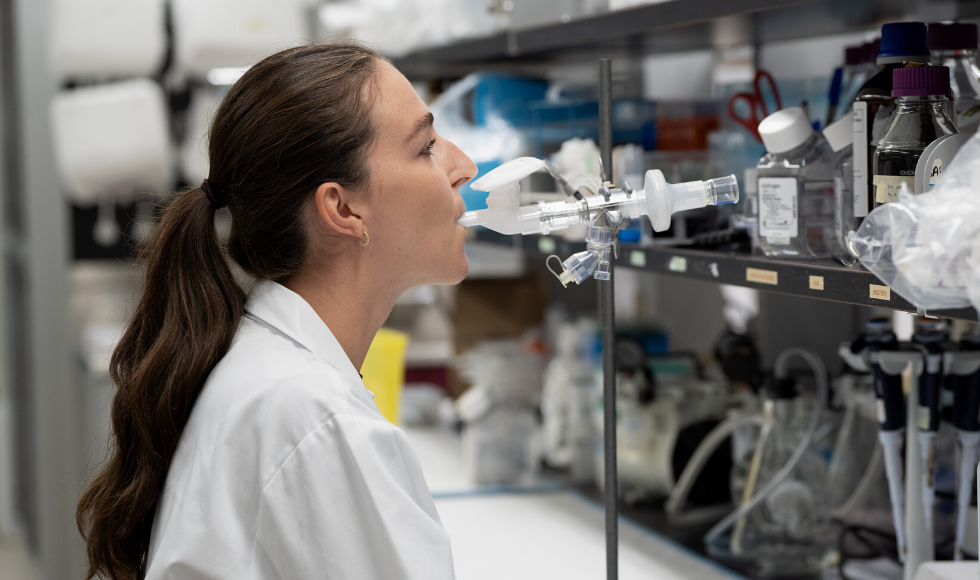The needle-free future of vaccines

A team of experts at McMaster is developing a second-generation COVID-19 vaccine that is inhaled through the mouth and delivered directly to the respiratory tract. (Photo by Georgia Kirkos/McMaster University).
November 21, 2022
Building on decades of research on an inhaled tuberculosis vaccine, a team of experts at McMaster is developing a second-generation COVID-19 vaccine that will offer a better defence against the current pandemic and future coronavirus outbreaks.
The new vaccine, designed to protect against future variants of concern, is inhaled through the mouth to deliver the vaccine directly to the respiratory tract. This could allow for the use of a much smaller dose when compared to traditional injected vaccines, which could mean lower costs and greater accessibility to life-saving vaccines globally.
The McMaster team has proven that inhaled vaccines are far more effective than both injected and nasal spray vaccine delivery systems. “The inhaled delivery system allows us to stimulate really potent immune responses in the lung, where infection occurs, that we simply can’t replicate with an injected vaccine,” explains Matthew Miller, Scientific Director of McMaster’s Michael G. DeGroote Institute for Infectious Disease Research.
The inhaled-vaccine technology, currently in human clinical trials, could be used to fight off other respiratory infections, including the common cold, flu and tuberculosis — an infection that killed 1.6 million people last year.
Targeting the virus at the source
Using the structure of an adenovirus as a vehicle to deliver the vaccine, the inhaled vaccine guts the virus of the genes that make it infectious and loads it instead with the antigens specific to SARS-CoV-2 that we want our immune system recognizes to prevent and fight infection. This teaches our immune system what the virus looks like so it can protect us should we be exposed to the virus in the future.
“The vaccine starts in liquid form and is loaded in a device that turns it into an aerosolized mist,” explains Miller. “The person who’s being vaccinated simply breathes in this mist and it gets deposited in their lungs.”
By inhaling the vaccine directly into our lungs, a large proportion of cells stay localized in our lungs and upper airways, the areas where we are most likely to encounter the virus should we become infected.
As a result, “your immune system doesn’t have to get called in from your arm or your armpit or wherever it’s residing from your injection to go into the lungs and fight COVID,” explains Brian Lichty, an associate professor in the Department of Medicine who is co-leading the vaccine development. “It’s already there and ready to go.”
Meet the researchers behind McMaster’s inhaled COVID-19 vaccines
The team is part of McMaster University’s Global Nexus for Pandemics and Biological Threats, an innovation hub for researchers from across disciplines to work in new ways with community, government and industry leaders to prevent pandemics.
“When we designed this vaccine we were thinking about the future,” says Lichty. “We knew that COVID would change. We designed our vaccine to anticipate those changes, by including portions of the virus that won’t change, and including portions that are conserved amongst other coronaviruses so that maybe it gives some level of protection against future possible pandemic coronaviruses that don’t even exist yet in the human population.”
The inhaled vaccine team did this by targeting three parts of the virus — the spike protein that the current generation of vaccines targets, which has the ability to mutate rapidly, as well as two additional parts of the virus that are much less prone to mutation.
“What we want to do is get ahead of the virus and be able to provide protection against any variant that might emerge in the future as opposed to constantly changing the vaccine by simply updating the spike every time a new variant pops up,” explains Miller.
“The viral vector COVID-19 vaccines that saved millions of lives around the world were built upon vaccine technology invented at McMaster University 50 years ago,” said Gerry Wright, Lead of the Global Nexus for Pandemics and Biological Threats. “Today, our researchers are again developing a transformative vaccine that will serve humanity now and for many years to come.”
In addition to being needle and pain-free, the inhaled vaccine delivery method is so efficient that it may be able to achieve maximum protection with a small fraction of the dose of current vaccines, meaning a single batch of vaccine could be used to protect more people than a single batch of the current injected vaccines.
The inhaled vaccine team comprises scientists Fiona Smaill, Zhou Xing, Matthew Miller and Brian Lichty. This groundbreaking development is part of the work being done at Canada’s Global Nexus for Pandemics and Biological Threats at McMaster, a global network of experts and partners who can act fast and act together in the face of serious and emerging threats to global health and well-being.


